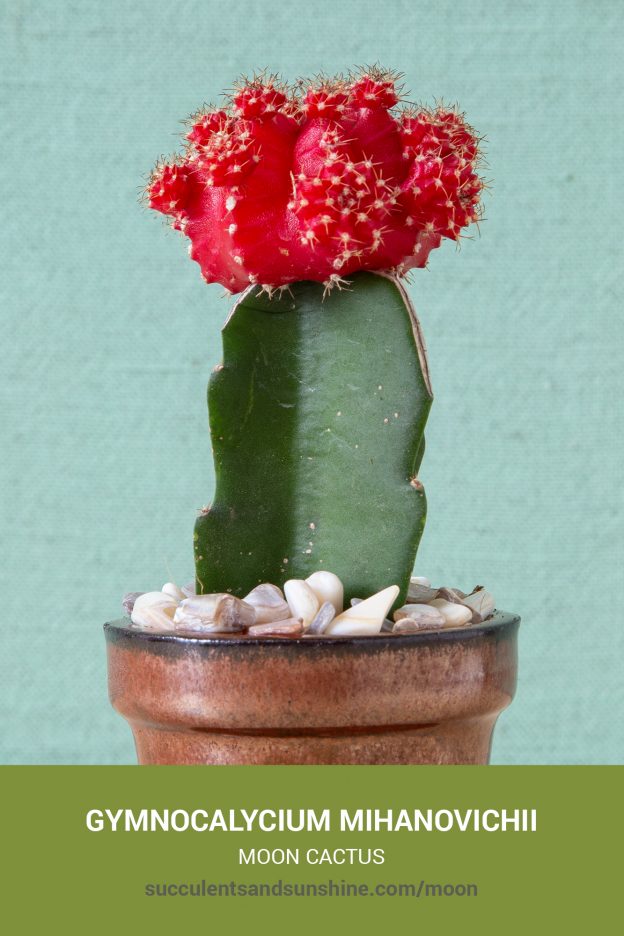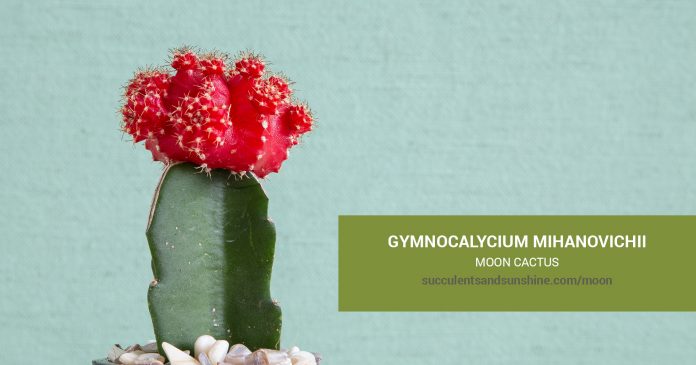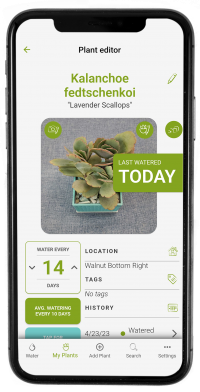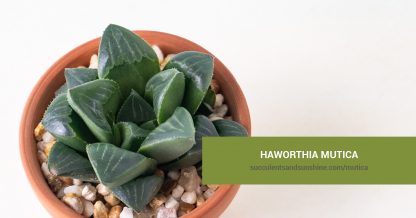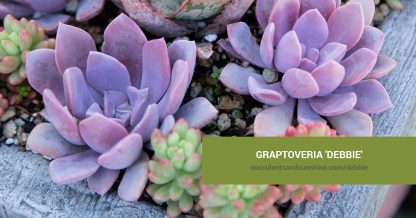Care and Propagation Information
General Care for Gymnocalycium mihanovichii “Moon Cactus”
Gymnocalycium mihanovichii “Moon Cactus” is a great cacti for beginners. It grows well indoors, and thrives on neglect. It is actually two separate cacti grafted together. The top, colorful graft comes from Gymnocalycium, with the rootstock cacti coming from another cacti. The colorful Gymnocalycium is a mutant, unable to photosynthesize, and therefore requiring nutrients from another cacti.
Watering
“Moon Cactus” has typical watering needs for a succulent. It's best to use the “soak and dry” method, and allow the soil to dry out completely between waterings.
Where to Plant
“Moon Cactus” is not cold hardy, so if you live in a zone that gets colder than 30° F (-1.1° C), it's best to plant this succulent in a container that can be brought indoors. It does well in full to partial sun.
Plant in an area of your garden that gets partial sun and shade. If planting indoors, place in a room that gets some sun and filtered light.
How to Propagate Gymnocalycium mihanovichii “Moon Cactus”
Not all Gymnocalycium mihanovichii “Moon Cactus” will produce offsets. Those that do can be propagated from the offsets. You can try to extend the life of your “Moon Cactus” by grafting it onto a new rootstock.
Offsets
Some “Moon Cactus” will produce small offsets, sprouting off of the top of the plant. Remove these carefully, and allow the offsets to dry for one to two days before placing in well-draining soil.
Reader Experience | Vinnie Schabacker
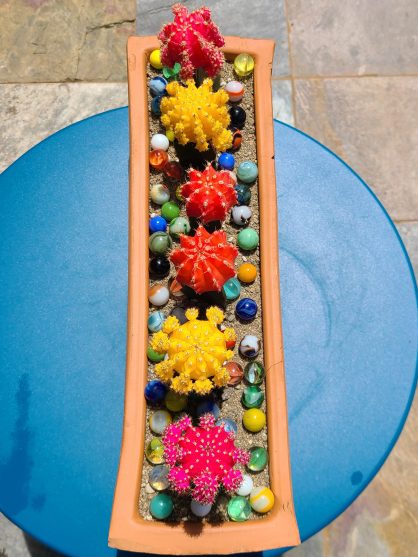
These are colorful, fun, novelty-type plants, easy to find, which are many people's introduction to grafted cactus.
The top part, called the graft scion, produces no chlorophyll of its own, and can't survive unless it is attached to a rootstock stem. Hylocereus undatus (Dragon Fruit Cactus) is the most common choice of rootstock, because it has few spines, and those are easily removed.
I currently have 3 sets of three of these plants! My oldest set is three years old now, so I should mention that these are considered short-lived plants, lasting from one to three years. Of course that can vary: perhaps as long as five years, or maybe only a month if it's overwatered.
The reason usually given for their short life spans is that these are a grafted union of two plants that grow at very different rates, and prefer different conditions. Hylocereus undatus is a fast grower, which can reach 20 feet tall. On its own, it's known for dramatic flowers and edible fruit, but not when it is joined together with a gymnocalycium cactus. Hylocereus likes some direct sun.
The "moon" part of a Moon Cactus can't protect itself in direct sun and will burn easily, but it does need bright light to keep its best coloring. The Dragon Fruit cactus can tolerate (meaning, survive) in bright indirect light with some partial shade.
Gymnocalycium mihanovichii won't grow more than a couple of inches across, and it's a slow grower compared to Hylocereus undatus. Over time, the different growth rates can split apart the grafted union. If it isn't regrafted, the colorful part browns and dies.
It isn't hard to re-graft a Moon Cactus. All it needs is a sharp knife, two fresh, clean, straight-across cuts, and a couple of rubber bands to hold the pieces together until the graft takes, generally a couple of weeks. But I haven't done that yet. Now I have a couple of spare rootstock pieces from former Moon Cactus, though, so I might re-graft next time one starts to fail.
People who know I grow succulents have gifted me one of these cute plants from time to time. That could happen to anyone! These are eye-catching.
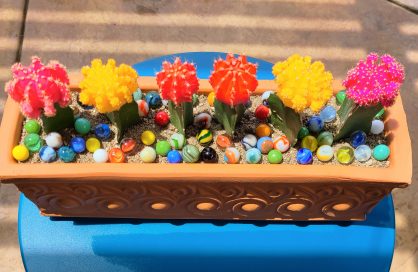
Tips for keeping Moon Cactus Healthy
Don't overwater. The rootstock can rot. I water very infrequently. I think this helps them reach the longer side of their life spans. I typically check to see if one of the "fins" of the Dragon Fruit Cactus is thinner than usual and perhaps a little bit bendy, before I give water.
I've grown these indoors under strong grow lights, and outdoors in bright light. Without good light, the gymnocalycium's bright color fades.
Outdoors, I keep them sheltered where they won't get a surprise watering from rain. They rot easily! I do keep in mind, though, that I could cut off the bottom of the rootstock, let it callus, and re-root it, if I spot a problem with over-watering in time.
I usually bring them inside or put them in a greenhouse for winter. I've seen a confusion with hardiness zones with this one. Some sources say Zones 10 to 12. One says 8 to 11. I'm in Zone 9b, and I left mine outdoors this winter. We didn't get any frost, but I have them under shelter anyway, to avoid rain rotting them. I can say mine showed no harm from air temperature dropping to 33° occasionally.
Extra fast-draining soil mixes can definitely help keep these around longer. I use about 80% pumice with the rest organic soil. Soil-free mixes would work as far as drainage goes, but these are inherently top-heavy and don't tend to have extensive roots, so they can be prone to tipping over in straight Bonsai Jack.
I never fertilize these plants. (Not that I do much of that, anyway, on any regular basis.) But knowing that different growth rates are a problem for the long-term survival of the Moon Cactus graft union, fertilizing would almost surely kill it sooner.
Mealybugs and scale can attack any succulents, but I've never had a pest problem with any of the Moon Cactus I've had over the years. I would spray isopropyl alcohol if I needed to manage pests.
The Moon Cactus may bloom! It is quite rare in my experience, though, and from what I've read. With however many of these I've had, I only ever had one form a bud. It was a large bud; gymnocalycium cactus have large, lovely flowers. I was so excited, I moved the plant so I wouldn't risk missing a moment of the flower, and that apparently was a mistake. The bud persisted over a month, and showed just a bit of color, but never actually opened.
I like to accent the cheerful look of these plants! Unglazed terracotta pots do help with plants prone to rot easily with too much water. But I like to use bright, colorful pots with Moon Cactus. Planting six of these together, I only had a terracotta planter available for the long, narrow style I wanted. Over-large pots for these would be a bad idea. I found another way to add some playful color.
